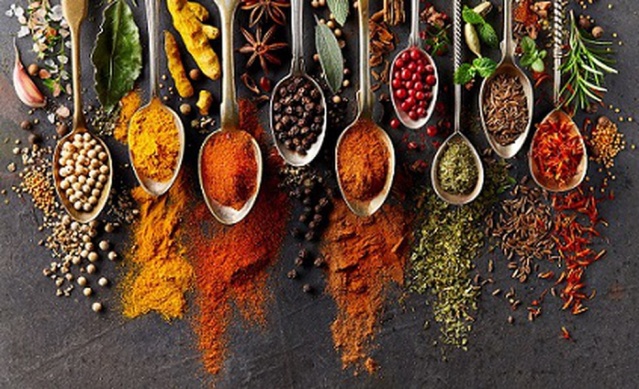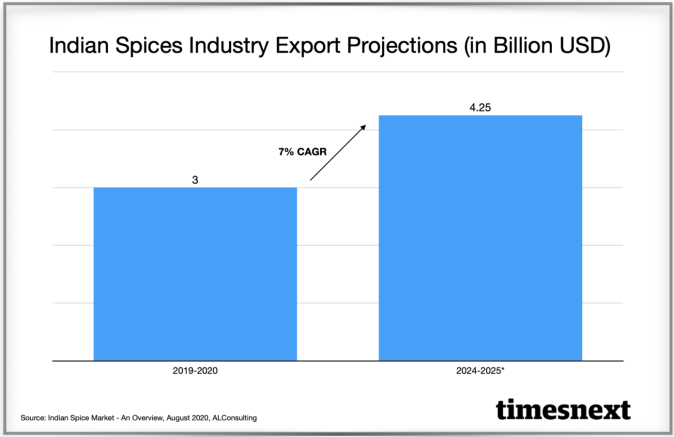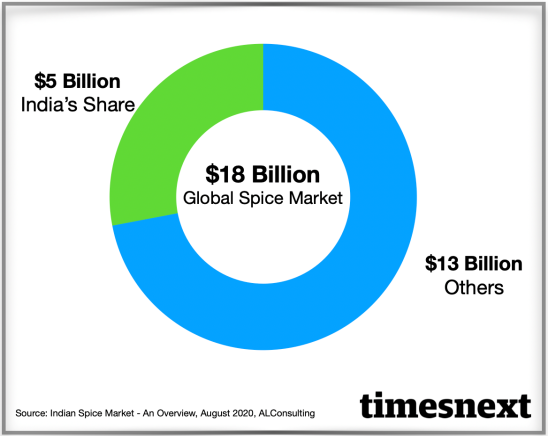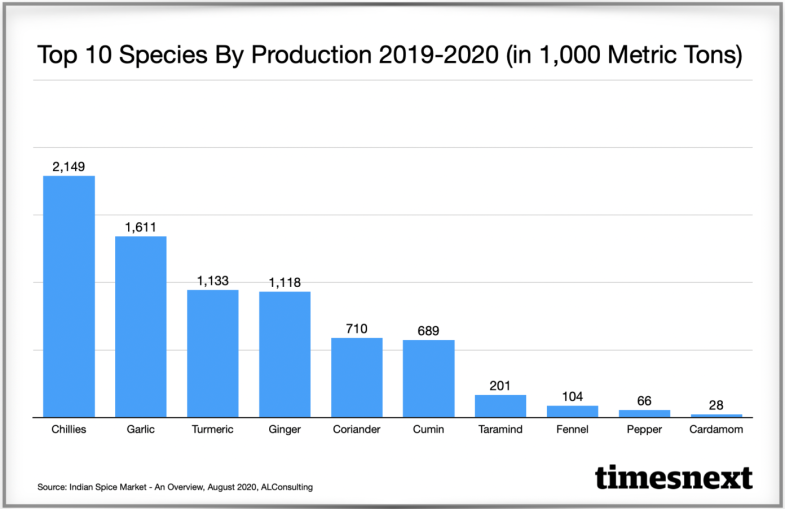Description

Disclaimer: Copyright infringement not intended.
Context
- Union Minister for Agriculture and Farmers Welfare released the book ‘Spices Statistics at a Glance 2021’.
About
- The book is a compendium of all the spices statistics like, area, production, productivity, export, import, price and value of output of various spices produced in the country.
- The book is published by the Directorate of Arecanut and Spices Development (DASD), Ministry of Agriculture & Farmers Welfare.
- DASD is the nodal agency for collection and compilation of area and production estimates of spices at National level.
- The book highlights the growth achieved in spices sector during the last seven years from 2014-15 to 2020-21 in the country.
|
About DASD
The Directorate of Arecanut and Spices Development (DASD) was established in 1966 at Calicut in Kerala as a subordinate office under Ministry of Agriculture, to look after the development of spices and arecanut at National level. The Directorate has the mandate for the development of spices, arecanut, a large group of aromatic plants and betel vine grown in the country at the National Level. The Directorate discharges the above function through the overall coordination of all the development activities implemented by different agencies like State Government Departments, State Agricultural Universities (SAU), ICAR Institutes etc. In addition, the Directorate undertakes implementation of certain critical programmes which are of vital importance in the development process. The Directorate is responsible for coordinating and monitoring programmes under Mission for Integrated Development of Horticulture (MIDH) to promote holistic growth of the horticulture sector in the country.
|
Findings
Production
- Spices production in the Country grew from 67.64 lakh tonnes in 2014-15 to 106.79 lakh tonnes in 2020-21 with an annual growth rate 7.9%, following an increase in area from 32.24 lakh hectare to 45.28 lakh hectare.
- Among the major spices, Cumin (14.8%), Garlic (14.7%), Ginger (7.5%), Fennel (6.8%), Coriander (6.2%), fenugreek (5.8%), Red chilli (4.2%) and Turmeric (1.3 %), show significant growth rate in production.
Exports
- The rapid stride in production has made available quality spices for export.
- This is reflected in the growth of spices export which grew from 8.94 lakh tonnes worth Rs 14900 crores to 16 lakh tonnes valued at Rs 29535 crores during 2014-2021, logging an annual growth rate of 9.8% in terms of volume and 10.5% in terms of value.
- The export of spices contributes 41% of the total export earnings from all horticulture crops in the country.
- Spice Exports ranks fourth among agricultural commodities, falling behind only the marine products, non basmati rice and basmati rice.
- India is the world's largest producer, consumer and exporter of spices.
- The country produces about 75 of the 109 varieties listed by the International Organization for Standardization (ISO) and accounts for half of the global trading in spices.
Some other statistics
- A report on Spices Market 2021-2026 by IndustryARC predicts that between 2019 to 2025, the spices market will continue to witness growth with a 4.80% CAGR because of the increasing demand for spices with the expanding urbanization trend.
- Apart from the food and beverage industry, spices’ end users also include pharmaceuticals and cosmetics.



The Major Growth Drivers of Spices
Development Programmes
- The spectacular growth of spices witnessed in the country is due to the various development programmes implemented by the Ministry of Agriculture & Farmers Welfare like
Mission for Integrated Development of Horticulture (MIDH)
- Rashtriya Krishi Vikas Yojana
- Pradhan Mantri Krishi Vikas Yojana
- Pradhan Mantri Krishi Sinchayee Yojana etc
DASD
- The Directorate of Arecanut and Spices Development through its planting material production programme and technology dissemination programme has played an important role in the spread of high yielding varieties which has significantly contributed to the drastic increase in quality spice production in the Country.
Recognition as Health Supplement
- The demand of spices has tremendously increased due to the recognition of spices as a health supplement especially during the pandemic period, which can be clearly seen from the growing export of spices like turmeric, ginger, cumin, chilli etc.
International collaborations
Blockchain powered traceability Interface for Indian spices:
- Spices Board India and UNDP India's Accelerator Lab recently signed an MoU to develop blockchain-powered traceability Interface for Indian spices to enhance transparency in supply chain and trade.
- This traceability interface is to enhance consumer confidence and facilitate sourcing of spices for exports as well as for local value addition and use.
Note
- Spices Board is one of the five Commodity Boards functioning under the Ministry of Commerce &Industry.
- It is an autonomous body responsible for the export promotion of the 52 scheduled spices and development of Cardamom (Small & Large).
- The main functions of the Spices Board are the following: (i) Research, Development and Regulation of domestic marketing of Small & Large Cardamom; (ii) Post-harvest improvement of all spices; (iii) Export promotion of all spices and assisting exporters in technology upgradation, quality management, brand promotion, research & product development; (iv) Development of spices in the North East; (v) Regulation of quality of spices for exports through its quality evaluation services; etc.
Codex Committee on Spices and Culinary Herbs:
- India became the member of Codex Alimentarius in 1964.
- India conducted sessions of Codex Committee on Spices and Culinary Herbs (CCSCH) at Kochi (2014), Goa (2015) and Chennai (2017).
- Recently in 2021, India was the Host of Fifth session of Codex Committee on Spices and Culinary Herbs. Spices Board India served as the secretariat of Committee.
- Codex Committee on Spices and Culinary Herbs (CCSCH) established under Codex Alimentarius Commission (CAC), describes the risk of unscrupulous and intentional adulteration of spices through substitution due to their high economic value.
- The aim is to develop and expand worldwide standards for spices and culinary herbs and consult with other international organisations in the standard development process.
Key Challenges faced by the Spice Sector
Low profitability
- Low profitability in the Spice area is one of the significant issues confronted the Indian Spice industrythat results in to low intensity in the global business sectors.
Farmers’ livelihoods
- Improving farmer livelihoods is a major issue in the agricultural sector, including spices.
- About 98 per cent of the spice production in India is by small-scale farmers, who typically farm less than two hectare and seasonally rotate the growing of spices alongside other crops. .(Gupta & Chandak,2020)
- Low and insecure farmer incomes, difficulties in accessing markets, limited access to health care and education and limited collective bargaining power are some of the social and economic challenges faced by small-scale farmers in the sector.
- Further, it also faces labour challenges such as child labour, poor working conditions and a lack of written agreements with the workers.
Disappearing varieties
- Because of the rapid disappearance of some indigenous assortments of flavors, some indigenous varieties are disappearing due to combining the effects of planting products with the depletion of inherited virtue.
Exports
- India is the largest producer and consumer of spices in the world today.
- Of the total volume of spices produced in India, only 10 per cent is exported.
- However, this constitutes 40 per cent of the global exports for all spices.
- As such, India has a unique position in the global spice industry.
- Spices continue to be a significant part of the country’s economy.
- However, as a largely agrarian country, India is faced with an immediate, at the root-of-it-all challenge – sustainability.
Insurance
- Crop Insurance is missing for Indian Spices.
- Remarkable normal catastrophes regularly drive these little and minor producers into an emergency circumstance.
- Little landholdings and less specialized expertise add to the issue.
Unsustainable
- One of the key issues affecting sustainability in the sector includes the overuse of agrochemicals, which has an environmental as well as a social impact.
- The challenges with respect to these include the irresponsible use of pesticides, the use of illegal substances, a lack of protective equipment leading to human health hazards, the improper disposal of chemicals and water contamination.
- The overuse of agrochemicals leads to high residue levels which, in turn, lead to the rejection of products and high costs for importers.
Some final thoughts and way ahead
- India’s spice trade dates back thousands of years, and it is still growing today with artificial intelligence, lifestyle changes and international trading shaping its future evolution.
- Forecasts suggest the spice industry will reach a global market size of almost $23bn by 2026.
- As the spice industry grows, new ways of catering to global demand have needed to be found.
- Part of the solution has been in the development of regional trade links.
- Addressing the above challenges through formalization of the sector, expanding insurance coverage, revamping infrastructure through investments and training of farmers for sustainable use of chemicals is the need of the hour.
- Spice trade has been heavily influenced by the way macroeconomic factors and consumer tastes developed over the years.
- Keeping a close eye on the way these are changing can help to open up new export destinations, disrupt established trade flows and even unearth new market segments for the products.
https://www.pib.gov.in/PressReleasePage.aspx?PRID=1784194














